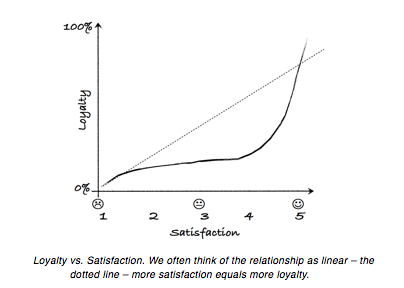Most of us experience a market situation that can best be described as hyper-competition. Supply out strips demand in virtually any category you can think of.
When that plays out advertising becomes less and less useful because there is already so much of it that few people, if any pay attention to it.
So the name of the game is customer loyalty – trying to draw customers closer to us in such a way that they are less tempted to switch to the competitions latest bargain offer.
Many companies use a variety of sophisticated marketing tools and tricks to do this from simple punchcards that give you your 10Th coffee for free to more elaborate loyalty clubs like what many Air Lines have developed.
But I don’t think that bribing customers to come back is what really counts. It may produce some form of customer renetion but there is no emotional loyalty.
What is loyalty then if not retention or what is the difference you may ask?
Well, there are two reasons we need customer loyalty. One is the obvious, that it is much cheaper to sell to an existing customer than it is to acquire a new one.That is the Customer retention part.
But more importantly loyal customers tell their friends – in fact the more loyal they are the more they talk about it – and that is what makes the all important difference between mechanicaly loyal and emotionally loyal.
When you have positive emotional feelings about a product or a brand you become an ambassador or what Fred Reicheld calls a ‘promoter’.(Here is a quick overview of the Net Promotor Score system)
Obviously in order for customers to become loyal they must first of all be satisfied to some degree. Customer satisfaction is the prerequisite for customer loyalty. But how much customer satisfaction does it take to create lasting loyalty?
From deeply dissatisfied to relatively happy, nothing much happens. Then, as satisfaction becomes more than just satisfaction and turns into enthusiasm, loyalty increases sharply.
But notice that when we deliver the right service/product at the right price, at the right time, and to the agreed-upon specifications, we score a 3 or possibly a 3.5 if we are lucky.
“Hey! But that is not fair,” you might be thinking, “we are doing everything perfectly and just as agreed, and all we get is lukewarm feedback!”
Doing everything perfectly and as agreed upon is exactly the problem. When clients read your marketing material or listen to your sales pitch, they learn that you will do this, this, and this for them at this price and on such and such terms.
So, who will be impressed when you actually deliver on what you said you would deliver?
You are performing exactly as expected. If you do less, they will be annoyed. If you do more, they will be en route to enthusiasm. If what you do far exceeds their expectations, they will be ecstatic.
But what can we do more than delivering everything we said we would?
We can establish an emotional connection. And because so few companies get it, it is still unexpected. When we touch our customers emotionally we exceed their wildest expectations.
Just think of a wonderful service experience you have had at some point. What made it exceptional? The mechanical stuff or was it because some one touched you at an emotional level some how?
Nine times out of ten you will find that what creates enthusiasm and loyalty is an emotional connection.
So forget the punch cards and the bonus points – what you need to work on is your team.
It is the attitude and loyalty of your team to your business that drives true customer loyalty. ( see my previous post on Employee loyalty here)
Loyal employees create loyal customers – that is the magic formula and that is also at the heart of the Service Profit Chain
